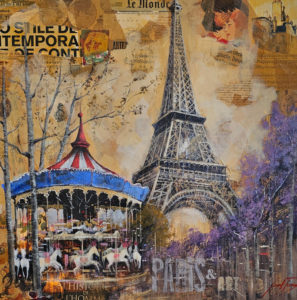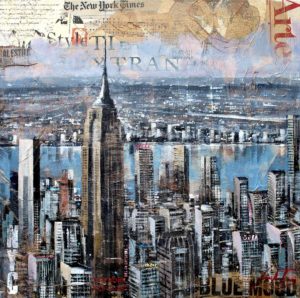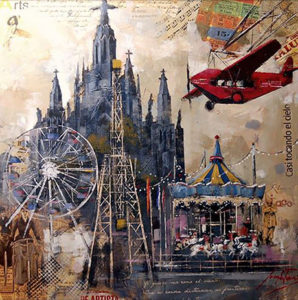UTRERA, 1960 Tenorio

He has the wisdom to express with his painting the feelings that come from reality and the world of dreams and interpretations.
From his trips he collects scores, letters, old manuscripts and press that later will be part of the collages that characterize his works.
BIOGRAPHY
Born in Utrera (Seville) in 1960, and self-taught, since childhood he participates in rapid painting competitions and completes his training at the Academy of drawing and painting of Carmen Sala, in Molins de Rei. His professional career has been rewarded with several prizes in painting contests. He has exhibited both nationally and internationally. Great part of its work is cataloged.
From his trips he collects scores, letters, old manuscripts and press that later will be part of the collages that characterize his works. Also posters of films, with what adds his liking to the cinema with the urban landscapes that he visits. The great expressive force that characterizes the work of Tenorio, together with a good use of technique, has allowed a personal diction before which the viewer does not know whether to admire the composition, drawing or color, or to surrender to perfection of the collage, turned into a color in addition to its palette.
A set of architecturally resolved urban themes, exponents of a painting where the feeling is not ignored, vibrate each stroke in the dense cuts of the spatula and vibrate, though, in the human presence that, despite its absence, s guess in his painting.
JUAN TENORIO TENORIO
by Ricardo Campos
Colored traps where time stops and Tenorio inoculates the precise movement so that the buildings precisely play at being people, and the people try to be inhabitants, the inhabitants detach themselves from their shadows and the shadows change the light, before the fugitive gaze of the captive spectator, who follows the cadent rhythm of thousands of cities with background music, impregnated with sheet music and love letters.
Innocent traps without further ado, where the magic of “collage” can transport you in a childlike way riding a paintbrush to a dollhouse overlooking Times Square.
To have a Cinzano in the Plaza Real.
Let’s read La Vanguardia in the Florián.
Or pass through a Puccini nod to jazz.
A red signature Tenorio.
TENORIO AND THE AMPLITUDE OF PICTORIAL THOUGHT
by Josep M. Cadena
Juan Antonio Tenorio has the wisdom to express with his painting, made of line and color, descriptive of facts and specific places that he has seen and heard throughout his travels, the feelings that come from reality and towards the world of dreams and interpretations. It keeps sensations, but also diversity of material testimonies that then, in the moment of putting oneself in front of the canvas to create with the forms, emerge and become essential elements of each painting.
The collages are important in his paintings. But not as complementary formulas in relation to some structures, but for themselves, for what they suggest. An imaginative person who has made himself, thanks to his great creative curiosity in relation to everything that surrounds him, has established concepts that, apparently dispersed in their origins, later fit into the general compositions. You have to look carefully at everything he says, since nothing of what he expresses through a plastic discourse that, in principle, is centered on a topic, without leaving the roots, grows and spreads in a diversity of situations. They are, of course, but they have a lot to do with our collective action, because they are daughters of commercial impulses, informative news, signs and lights that make intentional blinks to call our attention as citizens of a country and determinants moments that we have shared without perhaps knowing it, put in our things, without thinking that they were also others.
Tenorio’s painting is, at the same time, active in thought and balanced in forms. Build with harmony between the themes and their environment, but knows how to get out of everything that might seem corseted. He has the virtue of being free and of staying in this position, although he knows well the limitations that each person places on others in the name of collective interests. Using fantasy from reality, since he knows that from it he is free to build worlds in which ideas are much more solid and attractive than material realizations.
A field of wheat or barley -invent the example, since it is very possible in his way of expressing himself- can lead Tenorio to think of the waves of the sea and make them advance in an instant through an interior landscape, in the one that there is diversity of things. It combines the colors correctly, but also the impulses of thought. Get that the same has the fullness, deep down, asks the plastic.




